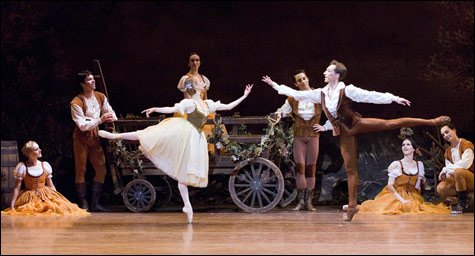
BETRAYAL: Larissa Ponomarenko and Roman Rykine in act one.
|
At 166 years old and sporting miles of white tulle, Giselle can look pretty moldy. With its frolicking-villager first act and ballet blanc second, it’s been the favorite of balletomanes ever since there were balletomanes. That might seem reason enough for everyone else to get the willies. But what’s kept Giselle going for 166 years is its timeless story of a man who loves — or at least wants — two women. At the Wang Theatre, as staged by Maina Gielgud, it’s being danced and acted with exemplary clarity by Boston Ballet, with some outstanding performances and a first-rate traversal of the score by the Boston Ballet Orchestra. The only thing missing on opening night was some audience fisticuffs over the casting, or one of the on-stage Russian wolfhounds taking a nip at a corps member. As hip as Boston Ballet is, it’s still not the Pops.
The setting is a picturesque Rhineland village during the fall grape harvest, and Albrecht and Giselle are in love. Giselle, however, has another suitor, the hunter Hilarion, who seems to think he has a claim on her. Is there a back story here? Was Giselle messing around with him before she met the more prepossessing Albrecht? And what’s Albrecht doing with a cloak and sword (which he stashes away before knocking on Giselle’s door)? Swords are for the nobility, not for village peasant lads. And why does Albrecht disappear when a hunting party including the Duke of Courland and his daughter Bathilde arrives? He misses the charming scene in which Giselle tells Bathilde she’s engaged. Bathilde is betrothed as well, though her fiancé, like Giselle’s, seems to be elsewhere.
No points for guessing that Giselle and Bathilde have the same sweetheart. The mystery is how Prince Albrecht — yes, our hero is nobility — expected to get away with it. Another ballet royal in the same predicament, Prince Siegfried in Swan Lake, solved his problem by refusing to marry any of the visiting princesses and standing by his swan sweetie. (And it would have worked if he hadn’t cheated on Odette with Odile.) But Albrecht can’t look either of his two women in the eye. Was Giselle meant to star in the ballet version of Seduced and Abandoned? Or does Albrecht really love her and just lose his nerve when Bathilde confronts him? Whatever, Hilarion finds the sword and presents it, Bathilde turns her back on Albrecht, and Giselle, who I forgot to mention has a dicky heart and shouldn’t really even be dancing, goes into cardiac arrest. Or does she actually stab herself with Albrecht’s sword, like Juliet sheathing Romeo’s “happy dagger”? (No points either for doping out the symbolism here.) Either way, she’s dead. Albrecht and Hilarion blame each other. The curtain falls.
Act one is day to act two’s night. Giselle has been laid to rest in the forest; why she wasn’t buried in the village cemetery is another mystery, unless it’s because the Church deemed her a suicide. The village church strikes midnight. Enter the grieving Hilarion, with lantern, and later Albrecht, with lilies. And of course the Wilis, the spirits of dead girls who were jilted and never saw their wedding day (and the likely source of the expression “get the willies”). They’re looking to avenge themselves by seducing and destroying young men — though in most productions of Giselle they’re not at all seductive. (Their queen Myrtha’s two subordinates are called “lieutenants,” which should tell you something.) Hilarion falls into their clutches and dances himself to death. Then it’s Albrecht’s turn. Will the newest Wili — Giselle — intercede for him? Will Myrtha’s heart soften when Giselle and Albrecht do their pas de deux? Will Albrecht’s fate hang on the caliber of his double tours and brisés volés? Or will Bathilde arrive at dawn to rescue him so they can live happily ever after?
Adolphe Adam’s score, which he wrote in less than a month, is often castigated as pretty and inoffensive and sub-Tchaikovsky, but Boston Ballet music director Jonathan McPhee has his orchestra performing it as if it were Tchaikovsky, finding drama and poetry and romance and not stinting on the cymbals. The Wang curtain rises on a front scrim that depicts a full-moon-lit lake framed by Grecian columns and sheer white curtains that fall like a bridal veil. This in turn rises to reveal Peter Farmer’s set, with Giselle’s humble wooden abode stage right and an equally modest wooden building (a shed? Albrecht’s bachelor pad?) stage left and the whole framed by birch trees (in Europe a symbol of fidelity) in a riot of autumn russet that gives the proceedings a claustrophobic feel. The costume colors — pumpkin and shades of brown and yellow — oversaturate the harvest theme; even some burgundy would be welcome.